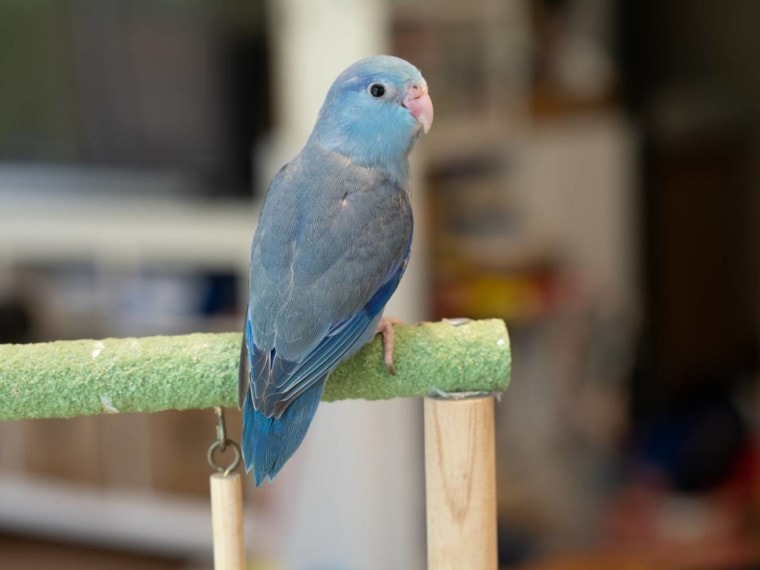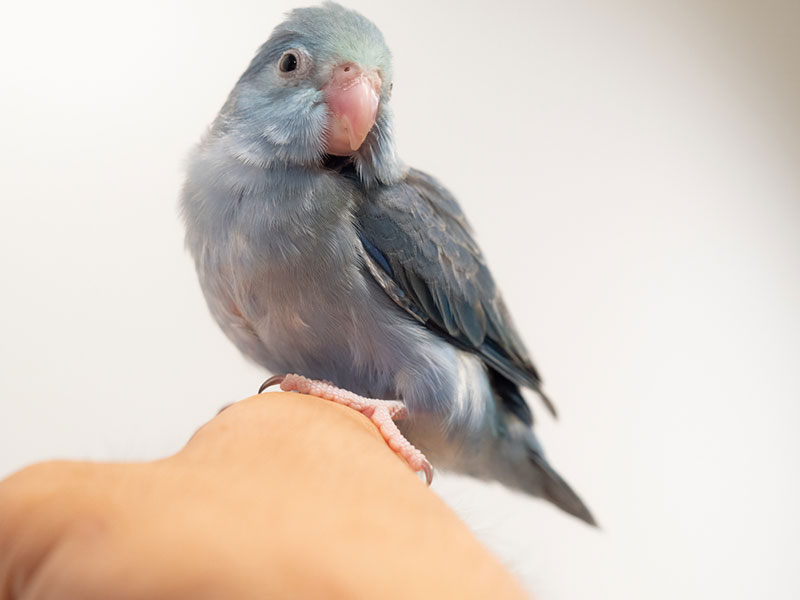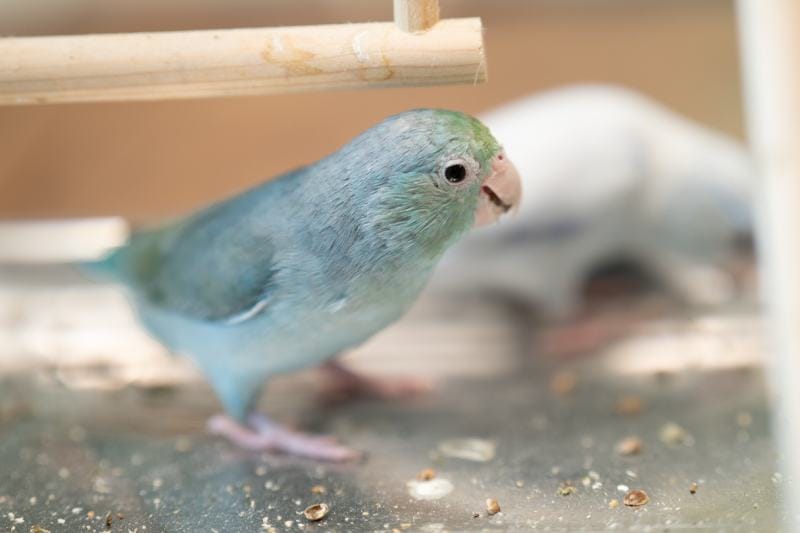
Whether you’re looking for a friendly companion to add to your home or you just want to know more about these adorable creatures and what they do in the wild, you’ve come to the right place.
The turquoise-winged parrotlet is a unique bird species that makes both a great pet and companion bird, and their smaller size makes them easy to care for. We break down everything that you need to know about these adorable birds here.
Species Overview
| Common Names: | Turquoise parrotlet, turquoise-winged parrotlet |
| Scientific Name: | Forpus spengeli |
| Adult Size: | 4.7 inches |
| Life Expectancy: | 15 to 20 years |
Origin and History
While the turquoise-winged parrotlet is extremely similar to other parrotlet species, it wasn’t until 2015 that we discovered that they were their own distinct species of bird.
Studies in 2016 quickly backed up the 2015 findings, and today, parrotlets make up their entirely own species.
If you’re looking to spot a turquoise-winged parrotlet in the wild, you’ll have to head to a small area in Northern Colombia.
These small parrots inhabit drier and open woodlands, savannas, palm groves, scrubland, and pastures, and if you spot them, they’ll likely be in abundance. They live in flocks of 50 or more birds, meaning finding one alone in the wild is an extremely rare occurrence.
While they have an extremely small natural habitat, they’re not facing any immediate threats to extinction. The IUCN has placed them at the level of “Least Concern” because the overall population is decreasing due to human interventions, but it’s not at the rate that raises any immediate concerns.
Temperament
The turquoise-winged parrotlet has a similar temperament to other parrotlet species, which is to say that they’re spirited and feisty, but they certainly have an affectionate streak in them.
However, like many birds, that affection can quickly turn to aggression if they don’t get the attention that they need to thrive. They have a decent amount of spunk, but they’re not birds that you want to deal with if they’re getting aggressive.
Despite their small size, they have extremely powerful beaks that can do a bit of damage, but as long as you’re giving them enough love and attention, you shouldn’t have to worry about it because they’re not that nippy.
These traits, combined with their smaller size, make them great pets for first-time bird owners who don’t want to deal with a temperamental and sometimes aggressive bird.

Speech & Vocalizations
The turquoise-winged parrotlet is a relatively quiet bird, although they are known to have the occasional outburst, especially if they’re not getting the attention that they need.
Their quiet nature makes them ideal birds to own if you live in closer quarters with other people, like in an apartment.
These beautiful birds can learn a few words and phrases, but they’re not nearly as talkative as other parrot species.
Turquoise Parrotlet Colors and Markings
Unlike many parrots that have identical-looking males and females, the turquoise-winged parrotlet has unique color patterns that distinguish males and females.
Males have bright turquoise feathers on their lower back near their tail feathers and have purple underwing coverts and axillaries. Meanwhile, females don’t have any of these extra colors and instead, have a slightly brighter face than males.
This means if you’re heading to a pet shop or a breeder, you can definitively say which sex of parrotlet you’re getting, which is a huge perk if you’re getting more than one bird.
Caring for the Turquoise Parrotlet
Like all birds, the turquoise-winged parrotlet requires a ton of work and attention to properly care for. You need to spend at least 4–5 hours with them outside of their cage every day, but they may require even more time outside of their enclosure to stay happy.
Despite their small size, you need a larger enclosure with tons of space for them to roam, and you need to rotate different toys in and out every few days to keep them entertained and exercised.
The cage dimensions should be at least 18” by 18”, but you need to keep bar spacing between ½” and 5/8” so their head doesn’t get stuck between the bars.
Like most birds, you should feed your parrotlet a pellet-based diet that you can supplement with fruits, vegetables, and seeds. Don’t overdo it with the treats, though, as they can get picky and refuse to eat their pellets.
You can pair the turquoise-winged parrotlet with other birds of their own species, but you need to be careful housing males and females together because of breeding.
Moreover, you shouldn’t house these parrotlets with birds of other species because they can get territorial, and this will lead to fights and other aggressive behavior.
Grooming activities with these birds are relatively minimal, although they should have enough water available to cool off in and clean themselves. If they don’t naturally bathe throughout the day, you will need to do it manually.
Still, like all domestic birds, you need to keep their wings clipped at all times so they can’t take flight and escape. Not only would this result in you losing your bird, but it would likely result in your bird’s death because they’re domesticated and cannot survive in the wild.

Common Health Problems
Diet and Nutrition
Like most small parrotlets, the turquoise-winged parrotlet thrives off of a pellet-based diet. You can supplement that diet with fresh fruit, vegetables, and seeds, but you need to cut these up into small chunks so your parrotlet can easily eat them.
Don’t overdo it with the seeds, though, as this can quickly turn your parrotlet into a picky eater with an unhealthy diet. Keep food available for your parrotlet at all times, but change out fresh fruits and vegetables before they can rot.
Try to keep the diet about 50% pellets, 40% fruits and vegetables, and only about 10% seeds. Finally, ensure that there is calcium-rich food because this will help with bone density and keep them healthy.
Furthermore, ensure that your turquoise-winged parrotlet has access to water at all times.

Exercise
While these birds don’t have the largest range in the wild, that doesn’t mean they aren’t used to flying around.
Like all birds, the turquoise-winged parrotlet needs plenty of exercise both in and out of their cage. You need to spend at least 4–5 hours with your bird outside of their enclosure, although they’ll certainly appreciate more time out.
Inside their enclosure, they need multiple perches and toys to play with. This way, they get enough exercise even in their enclosure.
Where to Adopt or Buy a Turquoise Parrotlet
While you might have to wait or shop around for a turquoise-winged parrotlet, you can find them just about anywhere that sells birds.
This includes everyday pet stores, like Petco and PetSmart, and specific bird breeders, like FlyBabiesAviary.com.
Expect to spend anywhere from $250 to $500 on one of these birds, depending on where you find them and their specific lineage. Just keep in mind that you’re shopping for a specific species of parrotlets, so it might take time to find exactly what you’re looking for.
Conclusion
While the turquoise-winged parrotlet is an extremely adorable species, before you adopt one, ensure that you have both the time and financial resources to care for them for the next 15 to 20 years.
These birds are extremely intelligent creatures and usually only bond to one human, so the last thing that you want to do is rehome them later in life.
Featured Image Credit: JTKP, Shutterstock








